![]()
![]()
![]()
Use LEFT and RIGHT arrow keys to navigate between flashcards;
Use UP and DOWN arrow keys to flip the card;
H to show hint;
A reads text to speech;
68 Cards in this Set
- Front
- Back
|
Parkinson's Disease: Famous people with |
-- Michael J Fox.
-- Muhammed Ali. |
|
|
Parkinson's Disease:
Prognosis |
Slowly progressive and degenerative |
|
|
Parkinson's Disease:
What is disease progression in general |
The progression for Parkinson's Disease is: 1. Unilateral tremor. 2. Bilateral tremor. 3. Symptoms worsen. Onset of difficulties with ADL but can live independently. 4. Requires help with some or all ADLs. 5. Confined to wheelchair or bed. Maximally assisted. |
|
|
Spina bifida -- what are the root meanings of these two words |
Spina = spine. Bifida = split.
Spina Bifida literally means "split spine". |
|
|
Spina Bifida:
1. what is it ?
2. etiology? |
1, Spina bifida is a neural tube defect (neural tube is what becomes brain and spinal cord)
2, Etiology is unknown (idiopathic)
|
|
|
Spina Bifida: describe the 3 types |
1. Occult spinal dysraphism (OSD). -- presence of external manifestation but no protrusion. 2. Spina bifida w/ meningocele. -- protrusion BUT doesn't include spinal cord. 3. Spina Bifida w/ myelomeningocele. -- protrusion includes spinal cord or nerves roots. |
|
|
Muscular DystrophIES, as a category. Are they degenerative? |
Yes, MS or multiple sclerosis is a degenerative disorders. |
|
|
Muscular Dystrophies, as a category: Onset |
MD, or Muscular Dystrophy, can begin at any time during life. in Infancy, Childhood, or in Adulthood. |
|
|
Muscular Dystrophies, as a category:
1. What is its progression?
2. How is it diagnosed? |
1. MD, mulscular dystrophy, may be rapid and fatal, or may remain stable throughout life.
(Those starting early in life, tend to be more severe and progress more rapidly.)
2. Dx: Blood test for muscle enzymes or proteins |
|
|
Muscular Dystrophies, as a category:
Name 4 symptoms |
1. Low muscle tone, & weakness. (these contribute to abnormal movement pattern & delayed developmental milestones) 2. Oral motor feeding may be difficult 3. Deformities of the extremities and spine, (these are caused by muscle weakness) 4. Breathing difficulty. This may require tracheostomies or mechanical ventilators. Breathing difficulties often lead to death. |
|
|
define dystrophy |
Dystrophy is a disorder in which tissue or an organ wastes away. |
|
|
Muscular Dystrophy -- In the test prep course, what did she suggest we learn about Muscular Dystrophy? |
General info about MD and Duchenne's MD. |
|
|
(Duchenne's) do shanes Muscular Dystrophy: What gender gets it? |
Do shanes Muscular Dystrophy sex-linked to males. |
|
|
(Duchenne's) do shanes Muscular Dystrophy:
1. When is it usually detected?
2. What is the prognosis regarding a person's lifespan? |
(MD can have onset anytime in life. But do shanes hits early and is detected age 2 - 6)
2. The lifespan for someone with do shanes Muscular Dystrophy is usually in their early 20's. This is due to respiratory problems, infections, and/or cardiovascular problems. |
|
|
Huntington's Disease can also be referred to as what? |
Huntington's Disease can also known as Huntington's korea. (Chorea)
(Although technically, it is now referred to Huntington's Disease.) |
|
|
What is HUNTINGTON'S DISEASE, and what is it's prognosis? |
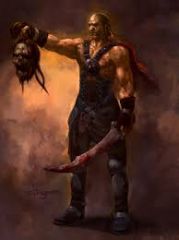
(Image: Huntington's Disease is a headhunter!) Huntington's Disease causes a progressive breakdown of nerve cells in the brain. |
|
|
Huntington's Disease is characterized by what 2 symptoms?
(Also, what third symptom MAY be involved?) |
1. Choreiform movement.
2. Progressive intellectual deterioration. . (Also, there may be psychiatric disturbance preceding onset of the movement disorder) |
|
|
ALS:
1. What's its complete name? |
ALS is Amyotrophic Lateral Sclerosis. |
|
|
ALS. What is it? |

[Image] ALS is an MND. ALS is a motor neuron disease. It is characterized by progressive degeneration of certain parts of the spinal cord. |
|
|
ALS:
1. onset is usually when?
2. death usually occurs when? |
1. The onset of ALS is at an average age of 57.
2. Death from ALS is usually 2-5 years after diagnosis. |
|
|
ALS:
What are the symptoms? |
The sypmtoms of ALS are primarily muscle weakness and atrophy. Many problems result from this, including dysarthria and dysphagia. |
|
|
What is the brachial plexus? |
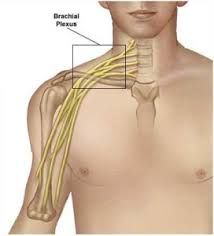
[Image]
The Brachial Plexus is a bundle of nerves in the chest that control the arm. |
|
|
Brachial Plexus Disorder:
1. What is the etiology?
2. What are some of the symptoms? |
1. Etiology. Traction during birth or otherwise; invasion of metastatic cancer, etc.
2. The symptoms of Brachial plexus disorder can be varied. They include motor and sensory disorders of the corresponding limb. |
|
|
Peripheral Neuropathies:
1. Where do they come from?
2. What does is cause? |
1. Peripheral neuropathy is damage to your peripheral nerves.
2. Peripheral neuropathy often causes weakness, numbness and pain. This is usually in your hands and feet. (It can also affect other areas of your body.) |
|
|
Guillain-Barre Syndrome.
What is it? |
Guillian-Barre is an autoimmune disorder. The body's immune system specifically attacks part of the peripheral nervous system. This causes demyelnation of the nerves. |
|
|
Guillain-Barre Syndrome.
1. When does recovery from this syndrome usually begin?
2. What is the potential long term prognosis? This question is not to be confused with the general progression, which is on another card. |
1. Recovery from Guillain-Barre Syndrome usually begins about 2 to 4 weeks after onset.
2. Potential long term prognosis is as follows. A small percentage die. Most are ambulatory in 6 months, (80%). Half display residual neurological effects. |
|
|
Guillain-Barre Syndrome.
-- what is the etiology |
The etiology of Guillain-Barre Syndrome is idiopathic. It may occur after an infectious disorder, surgery, or an immunization. |
|
|
Who gets Guillain-Barre Syndrome? |
Anyone can get it. |
|
|
What is the progression of Gullain-Barre Syndrome? |
Progression is rapid, goes from feet up:
1. Weakness or tingling sensations in the legs. 2. May spread to arms and upper body. 3. Increase in intensity until certain muscles cannot be used at all. When severe, the person is almost totally paralyzed. |
|
|
Myasthenia Gravis - what is its literal translation? |
Myasthenia Gravis means "grave muscle weakness".
(It is referred to as "weakness" because proper function in the neuromuscular junction can be reduced by 80% from this condition, not 100%) |
|
|
Myasthenia Gravis.
What is the usual progression? |
Myasthenia Gravis is usually progressively disabling. Death may occur from respiratory complications. |
|
|
Who gets Myasthenia Gravis? |
Everyone can. |
|
|
What is Myasthenia Gravis? |
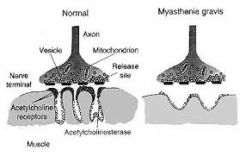
Myasthenia Gravis is autoimmune. It debilitates function of neuromuscular junction, causing muscle weakness. (Note the shallow "GRAVES" on image.) |
|
|
What are symptoms of Myasthenia Gravis? |
The symptoms of Myasthenia Gravis are.
1. Change throughout the day 2. Muscle fatigue after exercise 3. Dysarthria, dysphagia 4. Involvement of respiratory muscle may be life threatening |
|
|
What is M.S.? |
MS is multiple sclerosis. MS is an autoimmune disease. Bad T cells attack the myelin sheaths on neurons in the brain. Then info can't transfer well through these neurons. This results in varied problems throughout different parts of the body. |
|
|
What are some symptoms of M,S? |
Some symptoms of M.S. are: 1. Multiple and varied neurological symptoms and signs. These usually have remissions and exacerbations. 2. Weakness and clumsiness in the leg or hand is common. 3. Emotional disturbances . |
|
|
Name the 5 kinds of paralysis: |
1. Monoplegia: 1 extremity. |
|
|
Name the 5 kinds of paralysis (this includes the image of 5 types of paralysis) |
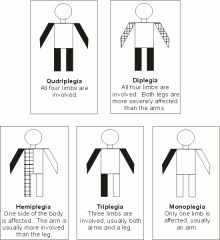
1. Monoplegia. 1 extremity. 2. Hemiplegia. upper & lower extremity of same side 3. Paraplegia. Legs only. (hint: parachute pants cover legs) 4. Tetraplegia. (prev quadriplegia) all extremities 5. Diplegia. Legs worse than arms |
|
|
What does the ASIA scale measure? |
The ASIA scale measures the degree of impairment and severity of injury of spinal cord injuries. |
|
|
What is autonomic dysreflexia. And tell what its symptoms are? |
1. Autonomic dysreflexia is an abnormal response to a noxious stimulus, like catheter blockage, sitting on a sharp object, etc. 2. The symptoms of autonomic dysreflexia are increased blood pressure, pounding headache, sweating. 3. It is deemed a medical emergency if not reversed quickly by removing stimulus. |
|
|
What is the full name for a TBI ? |
TBI is traumatic brain injury. |
|
|
What scales are used to rate where is a person is at after they have a TBI? |
The two scales used are the Glasgow Coma Scale
and
the Rancho Level of Cognitive Functioning. |
|
|
Rancho de los Amigos:
1. What is its full name?
2. What does it measure? (What is the memory trigger for this?) |
1. Rancho de los Amigos Levels of Cognitive Functioning.
2. Rancho los Amigos measures level of cognitive function. [HINT: the THREE AMIGOS! were low level cognitive functioning! They needed this test.] |
|
|
Rancho de los Amigos Levels of Cognitive Functioning:
What is the memory hint to remember the number of levels? |

[Image] Hint: Los tres amigos... times 3-1/3! (Visualize them introducing like in the movie, but they keep coming...10 times!) |
|
|
CVA: what is the full name and what is it? |
CVA is cerebral vascular accident, or stroke.
A CVA occurs from an insufficient blood supply to the brain, which causes tissue death. |
|
|
What are some of the functions of the left and right sides of your brain? |
Left: Right sided movement, processing, sensory info, & visual perception. Also Verbal processing. Bilateral motor praxis. Verbal memory. Speech. Processing verbal auditory. Right: Left sided movement, processing, sensory info, & visual perception. Plus visual spatial processing. Nonverbal memory. Emotion. Processing nonverbal auditory . |
|
|
S.C.I. - what does it stand for? |
S.C.I. stands for spinal cord injury. |
|
|
What is ortho-static hyper-tension? |
Orthostatic hypertension is a severe drop in blood pressure that occurs when someone assumes an upright position. |
|
|
What is spinal shock? |
Spinal shock, an issue in S.C.I., can occur during the first 4 to 8 weeks after a spinal injury. All reflex activity is gone below the level of injury, resulting in flaccid paralysis.
You have to let this run it's course BEFORE diagnosing. |
|
|
What is Osteo-genesis Imperfecta and what is the way to remember it according to it root words? |
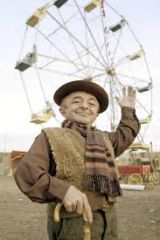
[Image] Osteo-genesis Imperfecta is imperfect bone growth. [HINT: the short character on the show CARNIVAL has it.] |
|
|
Osteo-genesis Imperfecta: name some of the symptoms. |
Some of the symptoms of Osteo-genesis Imperfecta include:
1. Brittle bones that easily fracture.
2. Multiple fractures as a growing child.
3. Deformities of the arms and legs. |
|
|
What are some of the ways to medically manage Osteo-genesis Imperfecta? |
Osteo-genesis Imperfecta can be managed medically in these ways:
1. Casts and braces.
2. Pain management.
3. Activity restrictions. |
|
|
Glasgow Coma Scale. What does it measure? |
The Glasgow Coma Scale is the most common scale used to determine the level of consciousness of a person after they've had a TBI. Basically, it's used the gauge the severity of an acute brain injury. |
|
|
Glasgow Coma Scale. What is the range for possible score and what do the highest and lowest scores mean? |
The scoring range for the Glasgow Coma Scale is from 3 to 15. A 3 means the person is in a deep coma or is dead. A 15 means fully awake. NOTE, therefore, that all component scores have a highest and lowest rating. A 1 for all of them means no response. Or this rhyme. . one is none. The highest score always means "normal". Just learn the middle scores. |
|
|
Glasgow Coma Scale. What are the different categories that are rated and added to determine a score. |
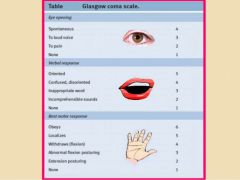
The categories rated for the Glasgow Coma Scale are:
1. eye opening. 2. verbal responses. 3. motor responses. |
|
|
Glasgow Coma Scale. How do you remember how many scores there are for each category? |
For eyes, think of the old nickname for kids with glasses. "4 eyes". . . For verbal responses, think that the word verbal starts with a V, which is roman for 5. For motor responses, think of a 6 cylinder engine. |
|
|
Glasgow Coma Scale. . Name all of the sub-ratings. |
Eye Opening (E). A score of 4 means eye opening is spontaneous. 3 is when they respond to voice. 2 is response to pain. 1 is none. Verbal Response (V). A 5 reflects normal conversation. 4 is disoriented, but coherent. 3 is words, but incoherent. 2 is only sounds, no words. 1 is none. Motor Response (M). A 6 is normal. 5 has the patient crossing mid-line to resolve a pain issue, like push an I.V. away. 4 means they withdraw from pain. 3 is decorticate posture, or flexion. 2 is decerebrate, or extenion. 1 is none. |
|
|
Glasgow Coma Scale. What do the final scores mean? |
Brain injury is generally classified as:
1. Severe, which is a score of 3 to 8.
2. Moderate. which is a score of 9 to 12.
3. Mild. which is a score of 13 to 15. |
|

What posture is this? |
Decordicate posture, in which the patient is in flexion. |
|

What posture is this? |
Decerebrate posture, in which the patient is in extension. |
|
|
What is C.R.P.S.? |
C.R.P.S., or CRAPS as I like to call it, is Complex Regional Pain Syndrome. |
|
|
What is neuro-pathic pain? |
Neuropathic can be broken down to "neuro-", or nerves, and "-pathic", which would mean disease. So neuro-pathic pain means pain that result from a messed up part of the nervous system.
Neuro-pathic pain is pain that results from lesions in some part of the nervous system. |
|
|
C.R.P.S. How many types of C.R.P.S. are there, name them, and describe them. |
There are 2 types of C.R.P.S.: Type 1 and Type 2. 1. Type 1 C.R.P.S. is pain characterized by abnormal burning pain & hypersensitivity to light touch. It's usually because of a traumatic injury. 2. Type 2 C.R.P.S. is pain occurring along the branches of a nerve. |
|
|
What is the full name of S.P.D.? |
S.P.D. is sensory processing disorder. |
|
|
S.P.D. What are some signs and symptoms of Sensory Processing Disorder? |
Signs and symptoms of S.P.S. include: 1. Hypo-sensitivity, sometimes called under-responsivity. 2. Hyper-sensitivity, sometimes called over-responsivity. 3. Tactile processing dysfunction. 4. Proprioceptive processing dysfunction. 5. Vestibular processing dysfunction. |
|
|
What is a seizure? |
A seizure is uncontrolled electrical activity in the brain that may result in physical convulsion, minor physical changes, thought disturbances, or a combo deal of these symptoms.
This depends on where the abnormal electrical activity takes place in the brain, what its cause is, and stuff like age and state of health. |
|
|
What are the intervention procedures if you are present when someone has a seizure? |
1. Remain calm. 2. Safety. Remove dangerous objects from area. 3. Safety. If person upright, gently glide them to floor and loosen clothes. 4. Safety. Turn him on his side to prevent chocking. |
|
|
What is the proper post-seizure care? |
Proper post seizure care includes: 1. Allow the individual to rest or sleep after seizure. 2. more stuff 3. Observe safety precautions is person seems groggy, confused, or weak following seizure. |

